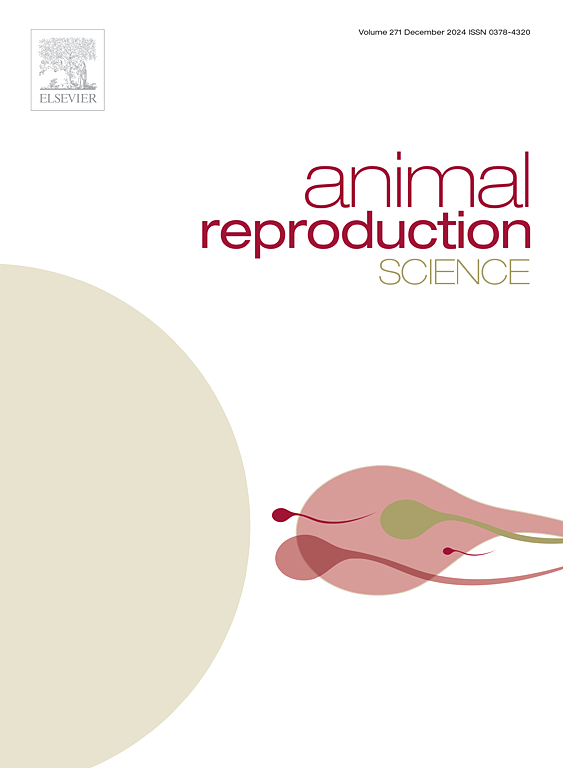Liquid storage of boar semen: Current approaches to reducing sperm damage using antioxidants and nanotechnology
IF 2.2
2区 农林科学
Q1 AGRICULTURE, DAIRY & ANIMAL SCIENCE
引用次数: 0
Abstract
Due to the high sensitivity of boar sperm to cryodamage, AI with liquid-stored semen is a widely adopted practice in the pig industry. Despite its widespread use, liquid storage at low temperatures adversely affects semen quality, leading to a progressive decline in reproductive performance over time. This deterioration is primarily attributed to cold shock and oxidative stress (OS), which results from the excessive generation of ROS that overwhelms the inherent antioxidant defenses of seminal plasma. Consequently, sperm motility, viability, plasma membrane and acrosome integrity, mitochondrial function, and DNA stability are compromised, which ultimately triggers apoptosis. As a result, fertility rates and litter sizes following AI with liquid-stored semen decline significantly, particularly after 3 days of preservation. This review provides an in-depth exploration of the fundamentals of liquid-state semen storage and elucidates the underlying mechanisms responsible for sperm damage during this process. It also further discusses various factors influencing the quality of liquid-stored boar semen and presents effective mitigation strategies with a focus on the incorporation of additives, antioxidants, and macromolecules into semen extenders. Lastly, this review summarizes recent advancements in the application of nanotechnology to enhance the liquid-state storage of boar semen and explores emerging strategies aimed at improving the quality of stored germplasm.
猪精液的液体储存:目前使用抗氧化剂和纳米技术减少精子损伤的方法
由于猪精子对低温损伤的高度敏感性,用液体储存精液的人工智能在养猪业中被广泛采用。尽管它被广泛使用,但低温液体储存会对精液质量产生不利影响,导致生殖性能随着时间的推移而逐渐下降。这种恶化主要是由于冷休克和氧化应激(OS),这是由于活性氧的过量产生压倒了精浆固有的抗氧化防御。因此,精子活力、活力、质膜和顶体完整性、线粒体功能和DNA稳定性受到损害,最终引发细胞凋亡。因此,人工授精后的受精率和产仔数显著下降,特别是在保存3天后。本文对精液液态储存的基本原理进行了深入的探讨,并阐明了在此过程中造成精子损伤的潜在机制。本文还进一步讨论了影响液体储存猪精液质量的各种因素,并提出了有效的缓解策略,重点是在精液填充剂中加入添加剂、抗氧化剂和大分子。最后,本文综述了近年来利用纳米技术提高猪精液液态储存的研究进展,并探讨了提高储存种质质量的新策略。
本文章由计算机程序翻译,如有差异,请以英文原文为准。
求助全文
约1分钟内获得全文
求助全文
来源期刊

Animal Reproduction Science
农林科学-奶制品与动物科学
CiteScore
4.50
自引率
9.10%
发文量
136
审稿时长
54 days
期刊介绍:
Animal Reproduction Science publishes results from studies relating to reproduction and fertility in animals. This includes both fundamental research and applied studies, including management practices that increase our understanding of the biology and manipulation of reproduction. Manuscripts should go into depth in the mechanisms involved in the research reported, rather than a give a mere description of findings. The focus is on animals that are useful to humans including food- and fibre-producing; companion/recreational; captive; and endangered species including zoo animals, but excluding laboratory animals unless the results of the study provide new information that impacts the basic understanding of the biology or manipulation of reproduction.
The journal''s scope includes the study of reproductive physiology and endocrinology, reproductive cycles, natural and artificial control of reproduction, preservation and use of gametes and embryos, pregnancy and parturition, infertility and sterility, diagnostic and therapeutic techniques.
The Editorial Board of Animal Reproduction Science has decided not to publish papers in which there is an exclusive examination of the in vitro development of oocytes and embryos; however, there will be consideration of papers that include in vitro studies where the source of the oocytes and/or development of the embryos beyond the blastocyst stage is part of the experimental design.
 求助内容:
求助内容: 应助结果提醒方式:
应助结果提醒方式:


